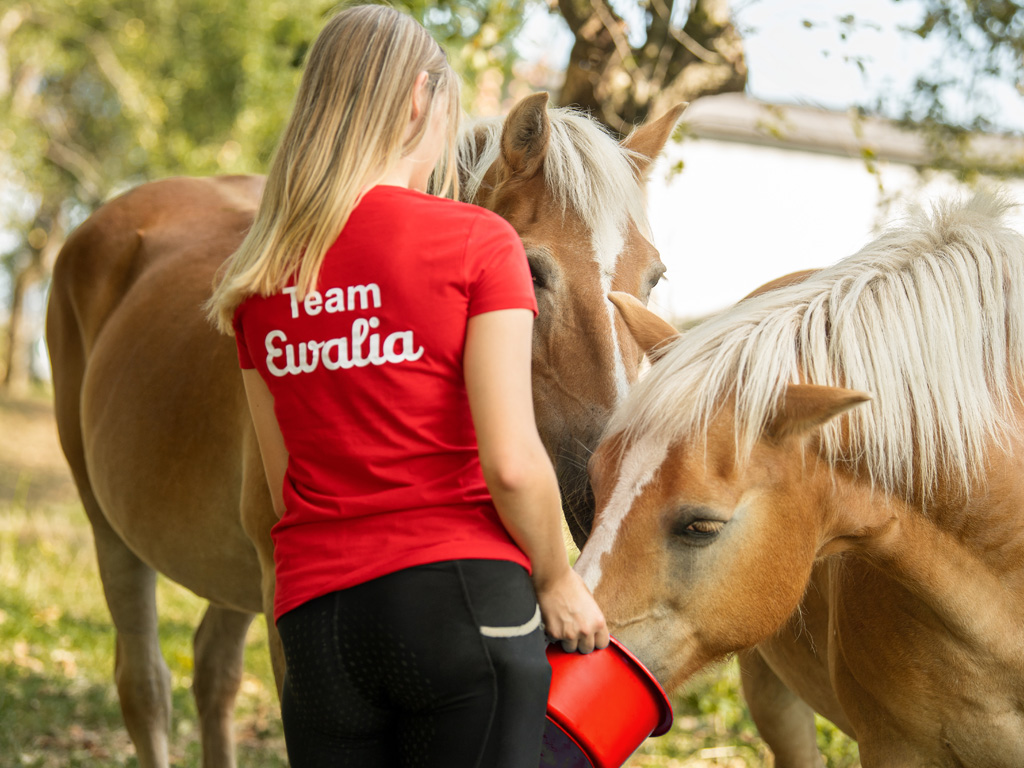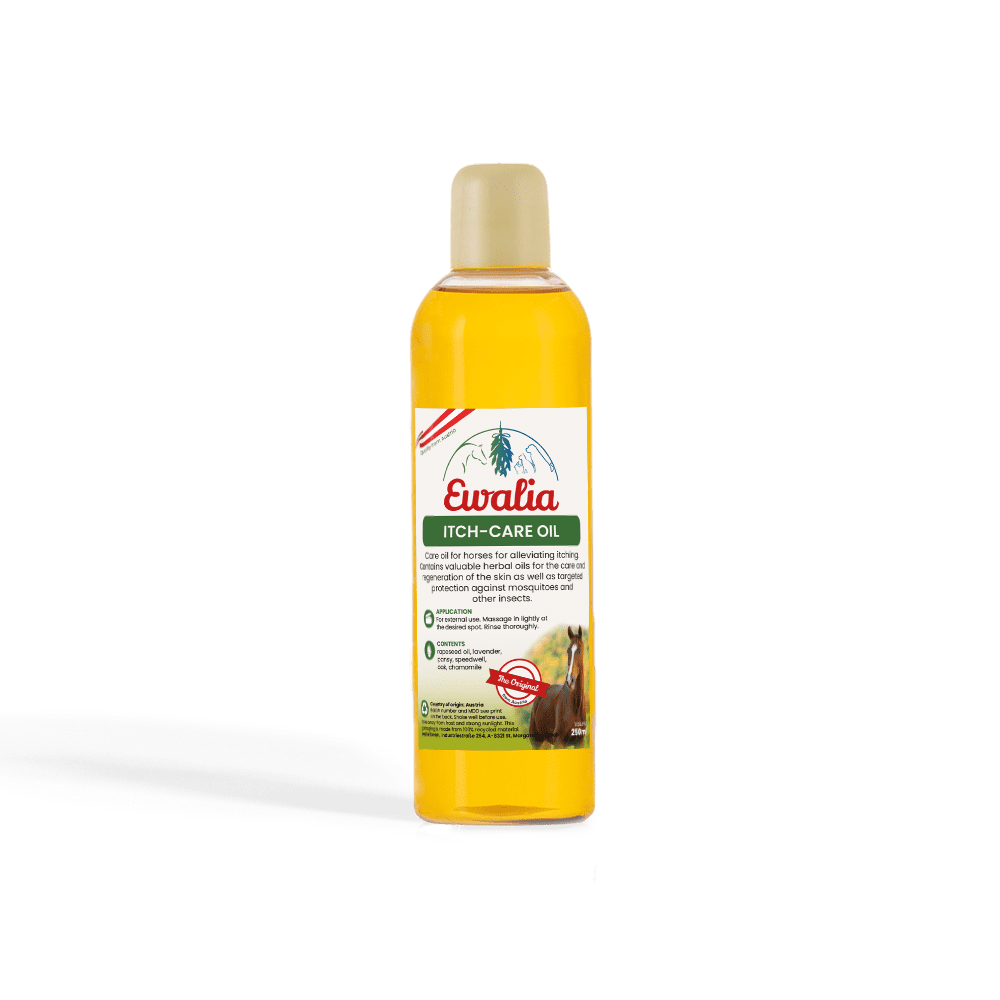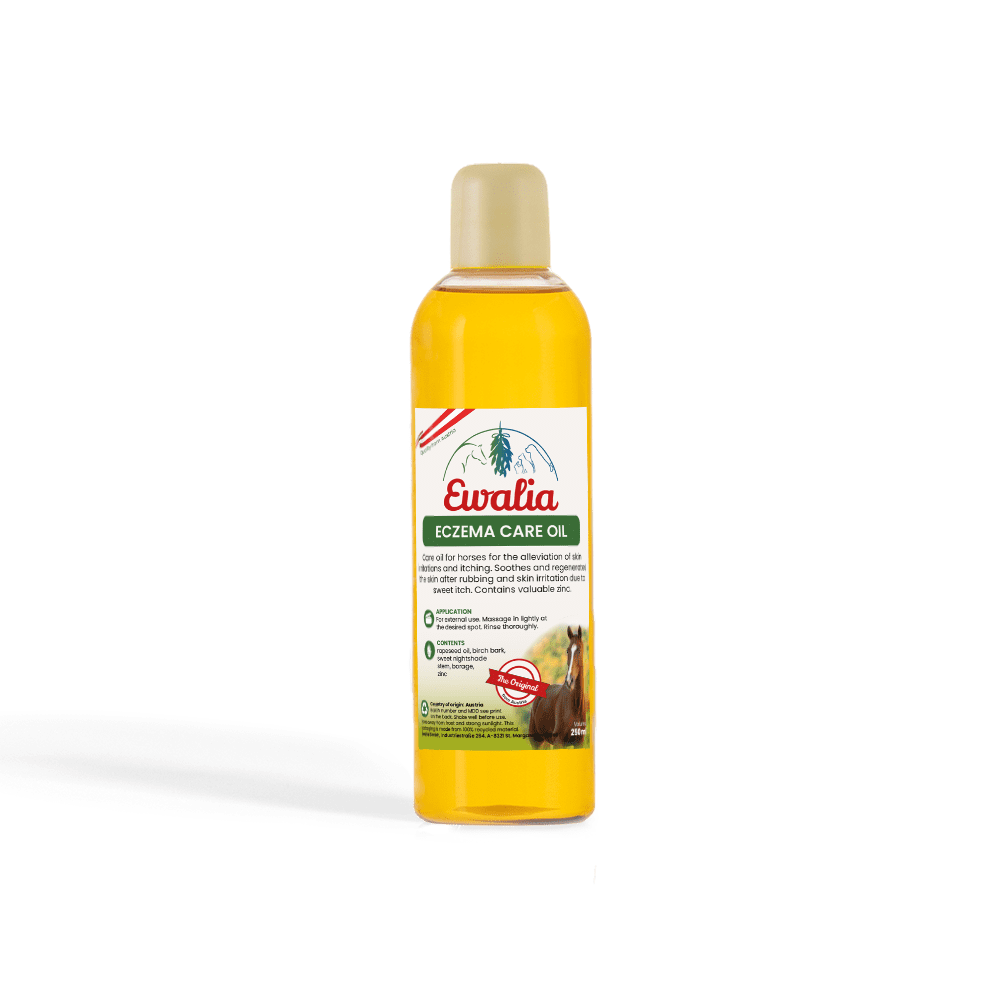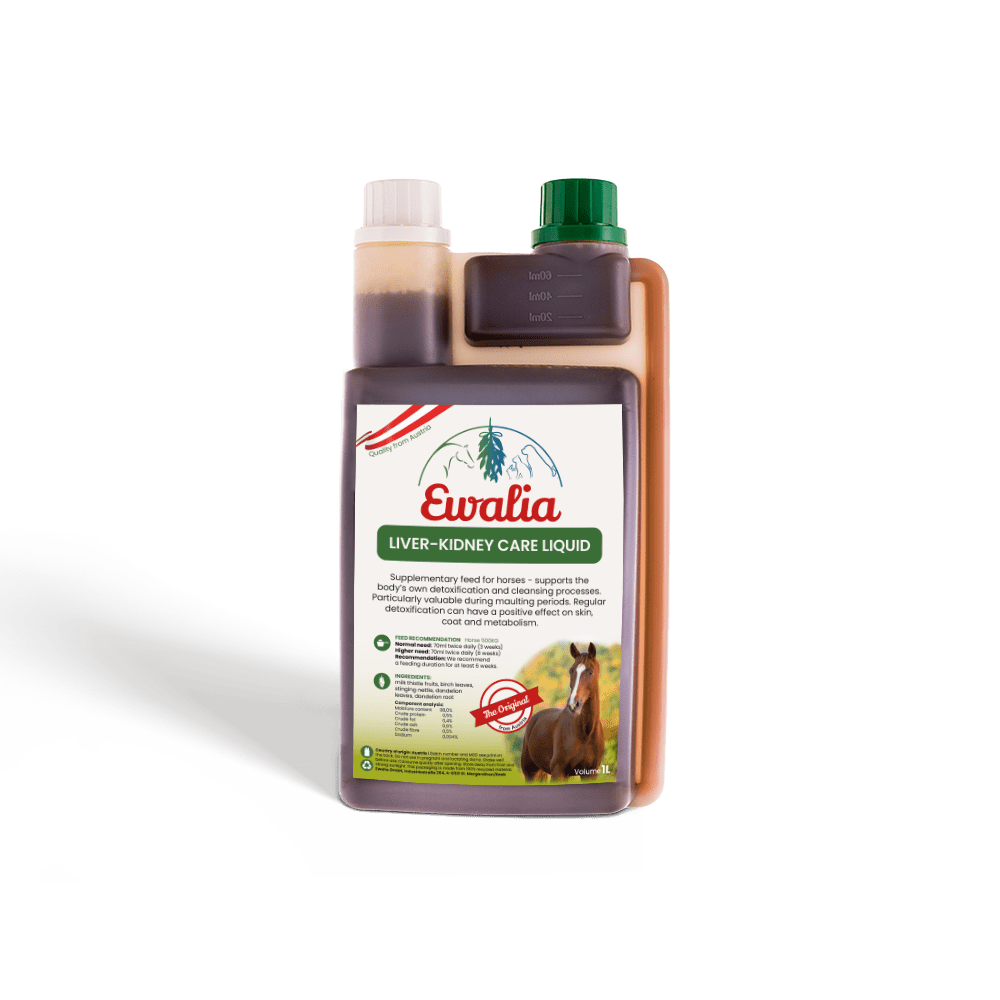Sweet itch in horses

Temperatures are rising, the first insects are on their way and your horse is already scratching its mane and tail like crazy on the pole fence. Every year, the itching phase starts all over again in spring and usually only ends with the onset of winter. We have a few tips to bring your horse relief, and some information on the topic of sweet itch: What is sweet itch and how can I help my itching horse?
» What is classic sweet itch in horses?
» What are typical symptoms?
» How can i support my itching horse?
» How can herbs and herbal mixtures help?
What is classic sweet itch in horses?
In principle it's a hypersensitivity reaction of the immune system of your horse, reacting to the saliva of mosquito-like insects like Culicoides ssp., midges, Simulium and blackflies. So it's a type of allergy. You can't predict why and from when exactly in the season your horse will develop sweet itch. It can basically affect any breed of horse, any gender and any age. The saliva from the mosquito-like insects enters into the organism of your horse. It contains special proteins that constitute an antigen. The horse's body reacts to this antigen by forming antibodies and tries to fight the antigens in this way, causing an immune reaction. If the immune response is very violent, one speaks of a hypersensitivity reaction. Your horse becomes sensitised to the saliva, to put it that way, and develops an allergy. From this point on it is referred to as classic sweet itch.
What are typical symptoms?
Various symptoms are not always clearly attributable to sweet itch, as nervous behaviour and itching in horses can also have other causes. In any case, the symptoms of sweet itch characteristically appear on the mane crest, withers, croup, tail rump or also on the belly. After a sting, swellings appear that can be overlooked at first - more noticeable is the nervous behaviour of the affected horse, which is plagued by itching and tries to drive insects away by beating its tail, rubbing or even hitting its hind leg under its belly. Often this promotes loss of coat and skin damage in the affected areas, which encourages secondary infections. Finally, open wounds are a breeding ground for pests of all kinds.
How can I support my itching horse?
You can't cure an allergy as such, but you can still do something for your horse.
Always protect your horse with sweet itch from more stings!
There are several ways of doing this:
- a sweet itch rug (even if everyone says :"the poor horse, he's always got a blanket on". A horse with true sweet itch loves his blanket, because it means less itching and less suffering.)
- Keep him stabled at dawn and dusk (at these times insect activity is at its highest. In the direct midday sun there are usually fewer insects.)
- Open stable with the possibility of withdrawing into a dark brick stable (you'll see, your itcher will spend a lot of time there on his own volition)
- Avoid having stables and grazing in the vicinity of water (damp areas, lakes, damp grazing etc. attract insects).
- Use insect traps and insect repellent sprays
- Summer grazing at higher than 1800m above sea level (if you horse is very badly affected in summer, he will be happy about living in an insect-free zone in summer.)
Fight dandruff!
With the allergic reaction, the immune defence responds through the main detoxification organ, the skin. More dandruff is formed on the mane comb, root of the tail, the areas under the eyes or in the ears. This itches very badly! Wash the dandruff out as well as you can. Keep the skin damp, for example with oil, so that the dandruff binds and the skin calms down again. Wash out the oil every 2-3 days, as this gets rid of old dandruff, for one, and on the other hand opens up blocked pores so that the skin can breathe again.
Give your horse feed that's low in protein!
This is easy to implement by feeding hay and lucerne adjusted to age, size, weight and work as a source of protein. Horses with sweet itch, especially, should not receive any additional protein as in concentrates. Feeding your horse a good mineral feed adjusted to the quality of your hay and its ingredients is also ideal.
Disinfect and treat wounds!
When your horse rubs himself hard and it results in direct skin injuries, you should make sure that the wound is cleaned and possibly treated with a healing ointment. It could otherwise quickly lead to further inflammation and even to infection and sepsis.
Allow some opportunities for rubbing, even with sweet itch!
Imagine itching really badly and someone makes it totally impossible for you to scratch yourself. That is just terrible and almost borders on torture. You could provide different kinds of brooms for rubbing, for example. Don't deprive your horse of the possibility of relief!
Stimulate the metabolism and detoxify several times a year!
Try to stimulate your horse's metabolism and the detoxification process. Your horse not only has mental stress during the summer, but his body is also working at full speed. The liver and kidneys often don't cope well with detoxification during a hypersensitive reaction. You can support this process with various herbs such as milk thistle, nettle, birch leaves and dandelion.
Medicinal herbs, herbs and herbal mixtures for sweet itch
Essential oils - defence and protection
Das ätherische Öl der Zitrone (Zitrus limon) ist beliebter Bestandteil zahlreicher Insektensprays. Der erfrischende Duft vertreibt erfolgreich Insekten und Plagegeister, und ist für ihren vierbeinigen Freund unbedenklich in der Anwendung. Der Anis (Pimpinella anisum) wirkt sich als traditionelles pflanzliches Arzneimittel nicht nur positiv auf unsere Atemwege und die Verdauung aus. Mit seinem arttypischen Geruch vertreibt er vielerlei unerwünschte Schädlinge. Der balsamische Duft von Zedernholzöl (Cetrus atlantica) wirkt unweigerlich entspannend auf unser vegetatives Nervensystem. Das ätherische Öl hat eine antibakterielle, entzündungshemmende und schleimlösende Wirksamkeit. Als Duftstoff wird es erfolgreich gegen Zecken, Motten und andere Plagegeister eingesetzt.
Der Eukalyptus (Eucalyptus globulus Labill.) ist ebenso beliebter Bestandteil in der Insektenabwehr. Beim ätherischen Öl wird zwischen verschiedenen Chemotypen unterschieden. So ist der Eukalyptus citriodora milder und bekömmlicher als andere Eukalyptusarten. Neben der Insektenabwehr wirkt das Öl zusätzlich antimikrobiell, entzündungshemmend, schmerzlindernd und antiallergisch. Die Arten der Gattung „Minze“ (Mentha) sind durchgehend reich an ätherischen Ölen, welche ist zu 50% Menthol enthalten. Dieses ist hauptverantwortlich für den arttypischen Geruch der Minzen. Als Heilpflanze ist Minzöl zur Behandlung von Erkältungskrankheiten, Verdauungsbeschwerden, Muskelschmerzen sowie Nervenschmerzen medizinisch anerkannt. In der Insektenabwehr dient Minzöl als hochpotenter Wirkstoff und wird ebenso in der Aromatherapie umfangreich angewendet. Für den würzigen Duft der Gewürznelken (Syzygium aromaticum) ist hauptsächlich der Wirkstoff „Eugenol“ verantwortlich. Dieser verleiht ebenso den Wurzeln er einheimischen Nelkenwurz ihren charakteristischen Duft. In der Aromatherapie wird das würzige Öl mit seiner antibakteriellen Wirksamkeit als schmerzlinderndes, entspannendes und lösendes Mittel sowie als wichtiger Bestandteil in der Insektenabwehr eingesetzt.
Fragrant herb bundles keep pests away
Other scents often used in insect repellents include rose geranium, sandalwood, patchouli, and lavender. Bundles of dried herbs can also be hung to keep insects at bay. Popular herbs for this purpose include lavender (Lavandula angustifolia), but also immortelle (Helichrysum italicum) with its antibacterial effect and pungent scent, green lavender cotton (Santolina viridis, also called holy flax, rue (Ruta graveolens) with its bittersweet aroma, and sweet woodruff (Galium odoratum), which contains coumarin. These herb bunches not only improve the air quality of the room: herbalists know of their insect-repelling properties and use them both in the stable for the animals and in their own homes and storage areas, along with herbal sachets in the linen cupboard.
Herbs to support the healing process and for care and strengthening
In addition to repelling insects, support for the healing process is also an important part of combating painful sweet itch. Give your animal's immune system an extra helping hand by feeding them low-protein food and activating the metabolism. The liver and kidneys are heavily involved in the body’s metabolic processes. Feeding your animal medicinal herbs like milk thistle (Silybum marianum), common nettle (Urtica dioica), birch leaves (Betula alba), dandelion (Taraxacum officinale), yarrow (Achillea millefolium), or chicory (Cichorium intybus L) as supplements can greatly help these processes.
Open wounds must naturally be disinfected and treated. Skin care is also important here as well. Use a mane come to carefully remove dead skin particles. Clean and treat the affected areas regularly. Don’t deprive your animal of the opportunity to scratch. Instead, apply soothing skin oils and creams that help eliminate the need to scratch to begin with. Certain medicinal herbs can be helpful here.
Vegetable oils, for example rapeseed oil, are gentle on the skin and make good base oils. Rapeseed oil is a popular ingredient in cosmetic and medical scar ointments because it moisturises and is absorbed slowly. It is rich in vitamin E as well as oleic acid and linoleic acid. These substances make rapeseed oil anti-inflammatory and cell regenerating. It also supports natural skin functions.
Birch bark (Betula alba) is used as a traditional medicinal plant product, both for internal use for cleansing treatments and rheumatic complaints, and externally to treat superficial skin wounds and slow-to-heal burns. Birch’s anti-inflammatory, antibacterial, and astringent properties make it effective for treating wounds.
Bittersweet (Solanum dulcamara L.) is also a herb used in traditional medicine. Its stem contains steroidal alkaloids, steroid saponins, and tannings. It is applied externally to treat chronic eczema – an aqueous extract is used as a poultice or in the form of creams and ointments. Caution: Bittersweet is a poisonous plant and should only be used for external application.
Borage (Borago officinalis) is from the family Boraginaceae and is closely related to comfrey. Like its “big brother”, borage contains the anti-inflammatory and wound-healing substance allantoin. It is also rich in silicic acid, mucilaginous substances, tannins, resins, saponins, and fatty acids. In fold medicine, borage is used to treat inflammations and rheumatic ailments, as a blood purifier, and for atopic eczema.
Zinc is, naturally, not a plant, but rather an important mineral with antibacterial properties. Application of a zinc ointment will “disinfect” the affected area and inhibit bacterial growth. This in turn promotes healing.
Lavender (Lavandula angustifolia) is known for its calming, soothing, and antimicrobial effects. In traditional medicine the plant is used as an ingredient in baths, creams, and ointments. Its essential oil is used in aromatherapy as well for treating wounds in folk medicine.
Wild pansy (Viola tricolor) is also a traditional medicinal plant. The European Scientific Cooperative on Phytotherapy (ESCOP) recommends the use of wild pansy for treating skin problems like eczema, seborrhoeic dermatitis, impetigo, acne, cradle cap, and nappy dermatitis. It can be taken internally as well as applied externally. Do not use pansy to treat animals that have hypersensitivity to salicylates.
The medicinal properties of speedwell (Veronica officinalis) are prized in folk medicine. It is administered internally for complaints of the respiratory, gastrointestinal, and urinary tracts, of the liver, and to boost metabolism. Externally it is used as a mouthwash, to promote wound healing, and for chronic skin ailments. Speedwell’s important substances include aucubin, which has antibiotic, anti-inflammatory, and soothing effects, as well as other iridoid glycosides, flavonoids, triterpene saponins, and trace amounts of tannins.
The European oak (Quercus robur L.) is considered a traditional medicinal plant. It is administered internally for treating mild diarrhoea, and externally for mild skin and mucous membrane inflammations. Oak bark is made into decoctions, baths, ointments, and poultices. It is also used externally to relieve the itching and burning of haemorrhoids as well as for the local treatment of mild inflammations in the mouth and throat as well as in the genital and anal areas. Oak’s active substances are its tannins, which have astringent properties.
Camomile (Matricaria chamomilla L.) is rich in flavonoids, phenolic acids, mucilaginous substances, and essential oil. Camomile is known in traditional herbal medicine for its soothing, calming, antimicrobial, and anti-inflammatory properties. Externally, it is used for inflammations in the mouth and throat and to help soothe inflammations in the anal and genital areas, as well as for mild skin inflammations (sunburn), superficial wounds, and small boils. Used in ointments, creams, poultices, and washes, it helps to heal wounds and soothe skin irritations.
Ribwort plantain (Plantago lanceolata L.) is a traditional medicinal plant. Taken internally, it helps relieve respiratory catarrhs, whilst external application soothes insect bites and skin irritations and promotes wound healing. Its active ingredient, aucubin, has antimicrobial, fungicidal, and soothing properties. Applying crushed ribwort leaves to insect bites will help to prevent them from itching and swelling. Other plants that contain aucubin are eyebright, mullein, and speedwell.
Lemon balm (Melissa officinalis), with its characteristic scent, is a traditional medicinal herb. Lemon balm is known for its sedative and soothing effects. Its antimicrobial, fungicidal, and antiviral properties make it useful in ointments and creams. Clinical studies have proven its effectiveness on sore skin due to herpes infections or infectious insect bites.
These are just a few of the medicinal plants you can use to help your four-legged friend. Also worthy of mention are marigold (Calendula officinalis), which supports natural skin functions and supports wound healing, and the common daisy (Bellis perennis), used in folk medicine in ointments and washes for skin rashes and minor injuries. When taken internally, daisy also has positive effects on metabolism. The list of healing herbs by no means ends here. Always consult with a specialist on the use of these herbs, as it is important that they be used in a coordinated manner for optimum effectiveness.
Source:
- Gerber, V., Venner, M., & Straub, R. (2016). Pferdekrankheiten: Innere Medizin (2. Auflage Ausg.). (V. Gerber, & R. Straub, Hrsg.) Bern: utb.Reichling, J., Gachnian-Mirtscheva, R., Frater-Schröder, M., Di Carlo, A., & Widmaier, W. (2008).
- Heilpflanzenkunde für die Veterinärpraxis. Berlin-Heidelberg: Springer Medizin Verlag.
- https://de.wikipedia.org/wiki/Sommerekzem
- https://www.feeling.at/web/natuerlicher-insektenschutz-die-besten-duefte-und-oele-gegen-muecken-gelsen-co/
- https://www.karger.com/article/Fulltext/477478
- https://arzneipflanzenlexikon.info/
- https://www.netdoktor.de/therapien/wundversorgung/wund-und-heilsalbe/
- https://wissenausdemmittelalter.com/2019/02/22/wundversorgung-im-mittelalter/
- https://www.andi-und-alex.at/
















